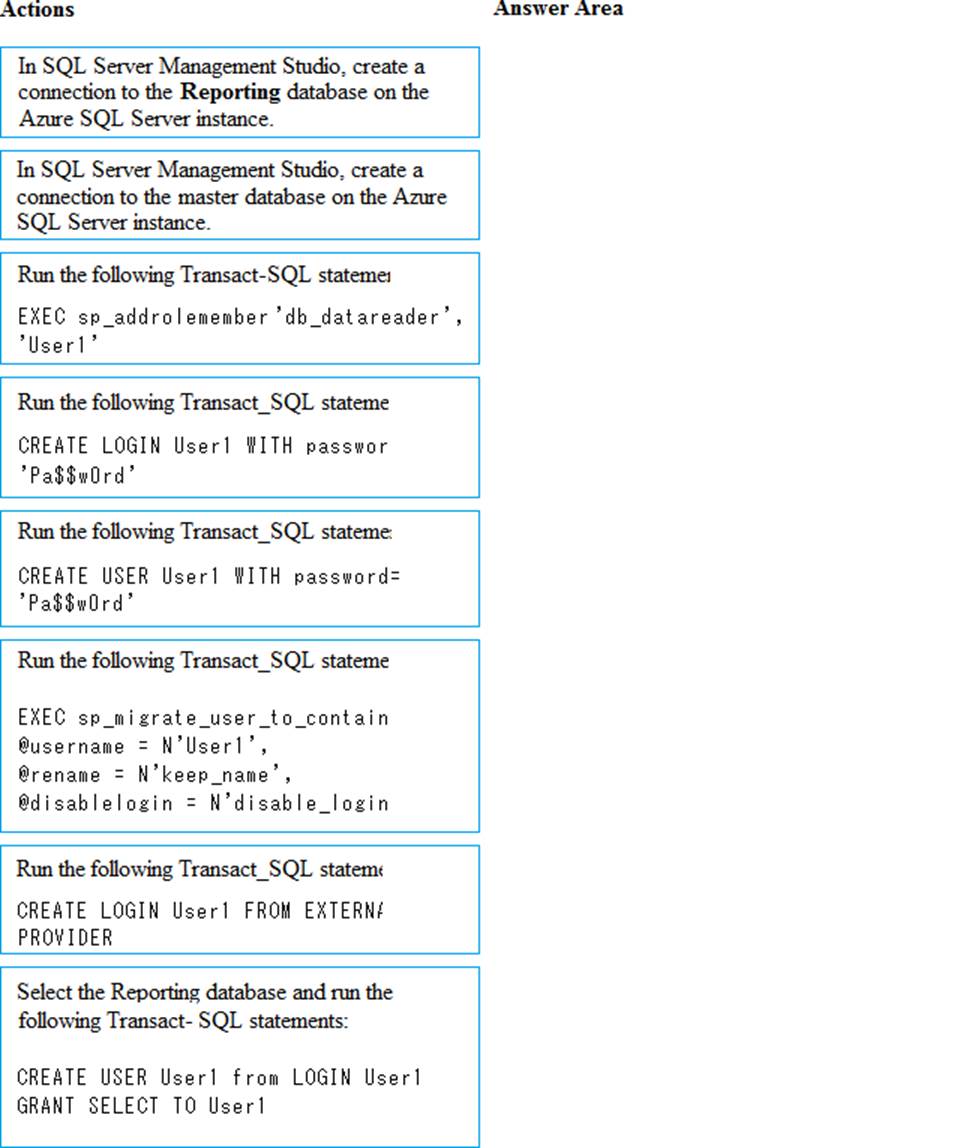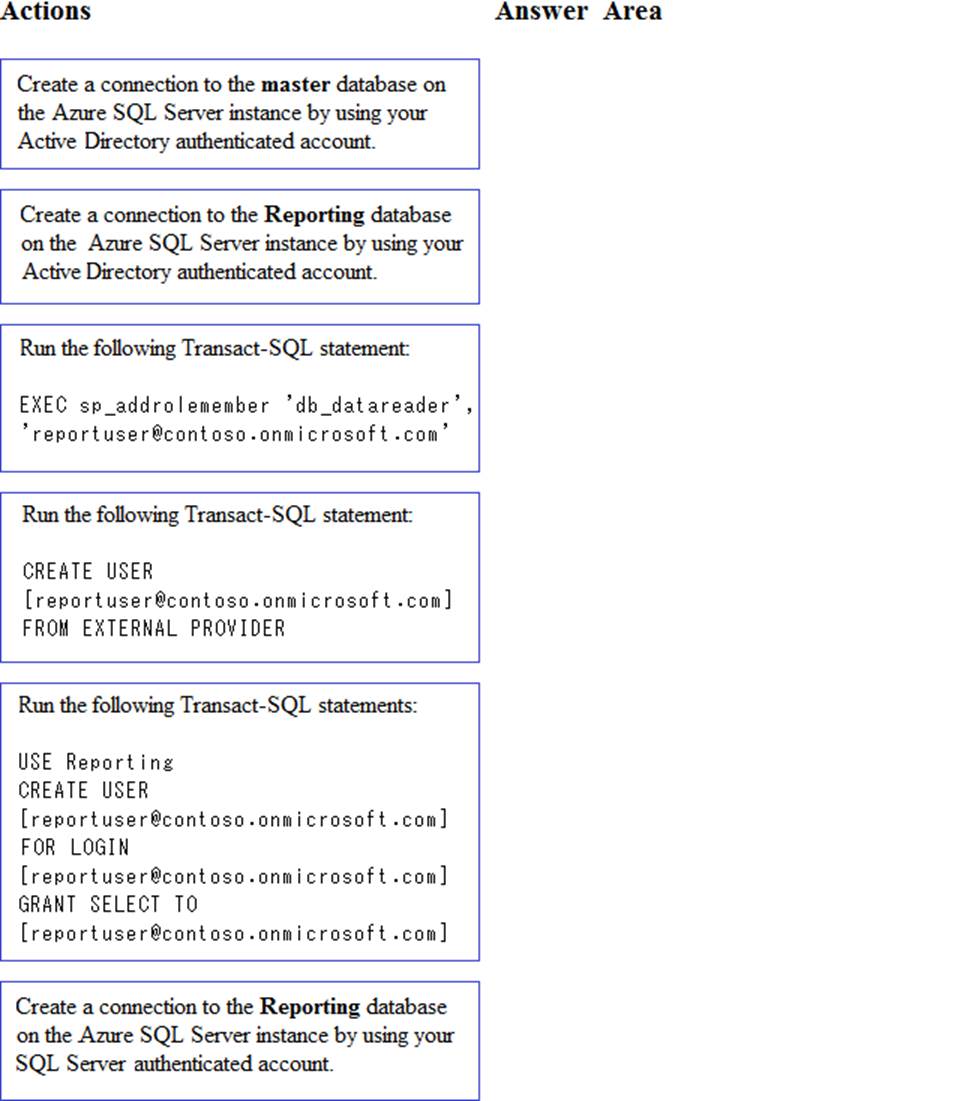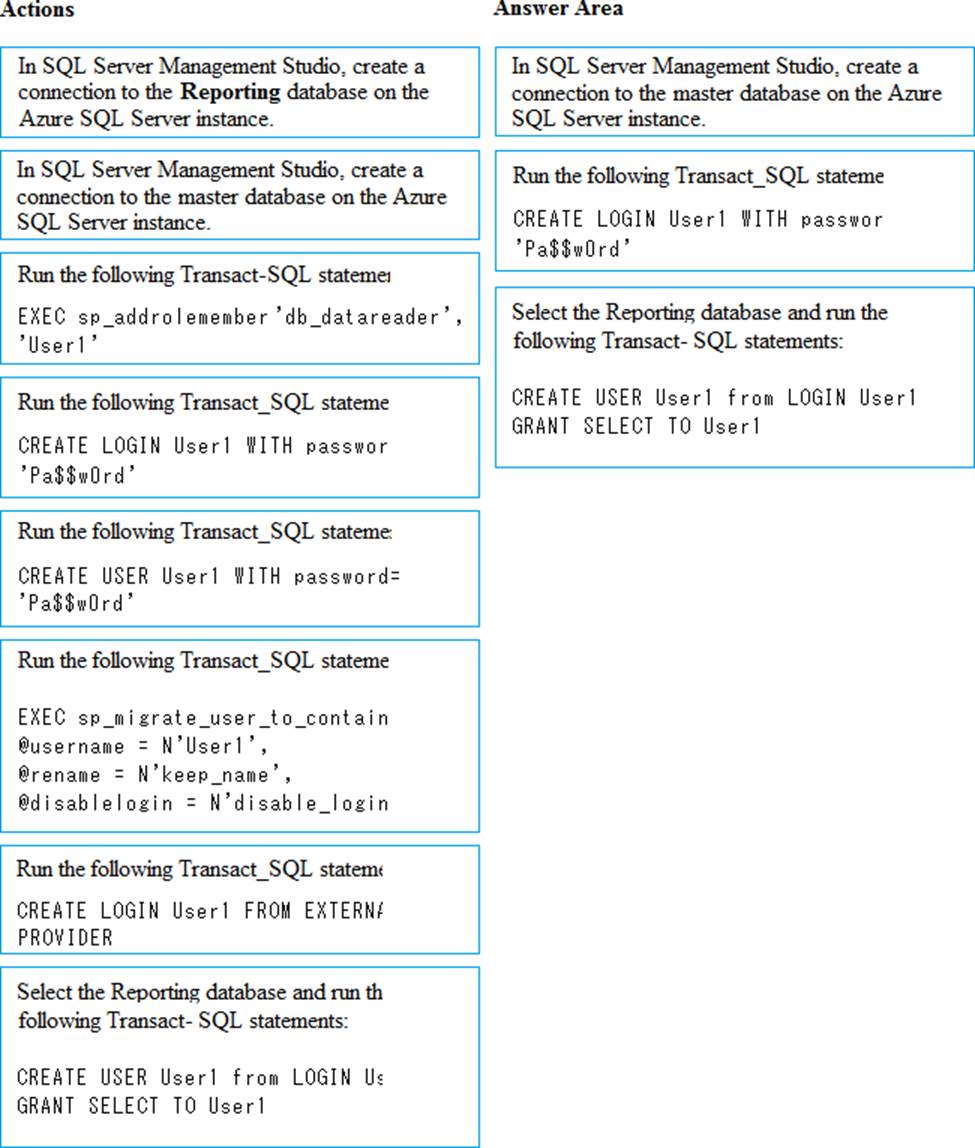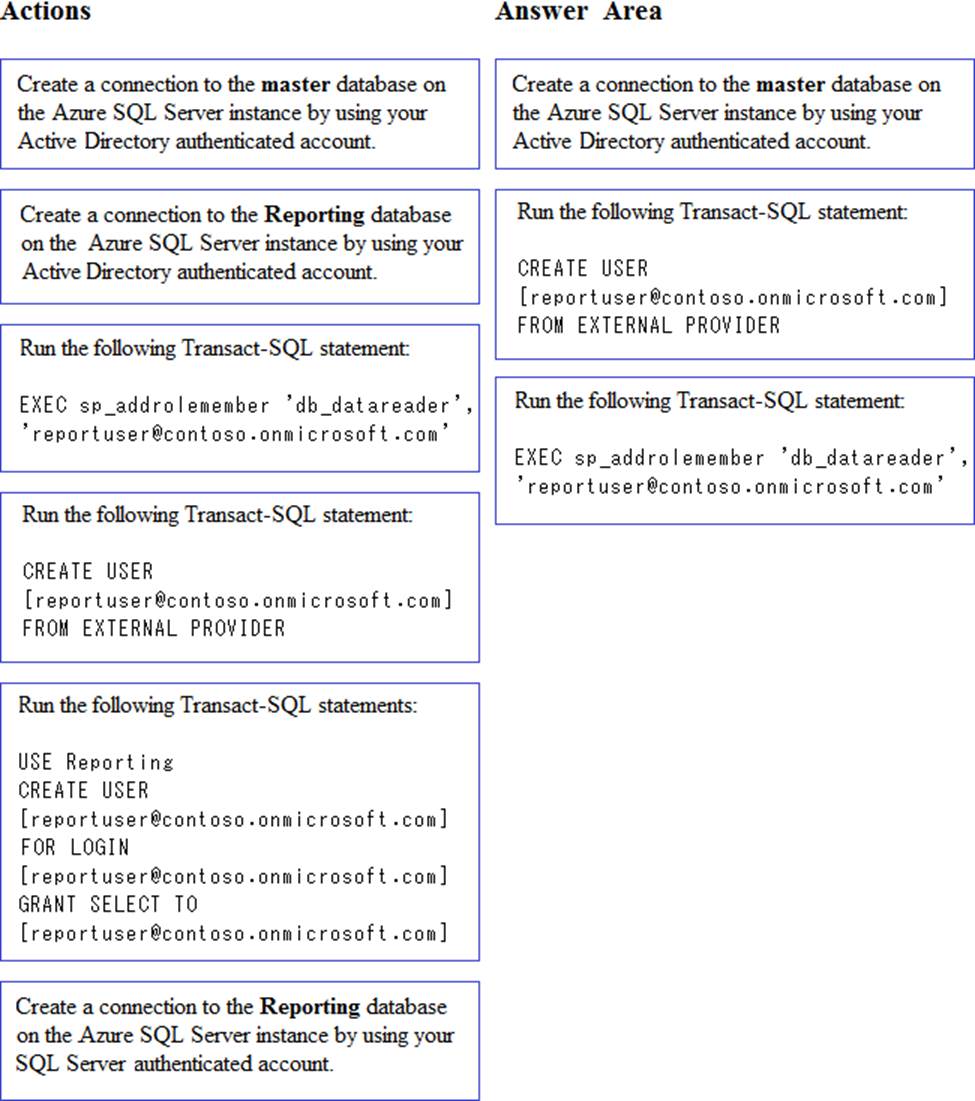Microsoft 70-765 Provisioning SQL Databases Online Training
Microsoft 70-765 Online Training
The questions for 70-765 were last updated at Dec 19,2025.
- Exam Code: 70-765
- Exam Name: Provisioning SQL Databases
- Certification Provider: Microsoft
- Latest update: Dec 19,2025
Note: This questions is part of a series of questions that use the same or similar answer choices. An answer choice may be correct for more than one question in the series. Each question is independent of the other questions in this series. Information and details provided in a question apply only to that question.
You manage on-premises and Microsoft Azure SQL Database instances for a company. Your environment must support the Microsoft SQL Server 2012 ODBS driver.
You need to encrypt only specific columns in the database.
What should you implement?
- A . transport-level encryption
- B . cell-level encryption
- C . Transparent Data Encryption
- D . Always Encrypted
- E . Encrypting File System
- F . BitLocker
- G . dynamic data masking
Note: This questions is part of a series of questions that use the same or similar answer choices. An answer choice may be correct for more than one question in the series. Each question is independent of the other questions in this series. Information and details provided in a question apply only to that question.
Your company has several Microsoft Azure SQL Database instances.
Data encryption should be allowed to be implemented by the client applications that access the data. Encryption keys should not be made available to the database engine.
You need to configure the database.
What should you implement?
- A . transport-level encryption
- B . cell-level encryption
- C . Transparent Data Encryption
- D . Always Encrypted
- E . Encrypting FileSystem
- F . BitLocker
- G . dynamic data masking
Note: This questions is part of a series of questions that use the same or similar answer choices. An answer choice may be correct for more than one question in the series. Each question is independent of the other questions in this series. Information and details provided in a question apply only to that question.
You deploy Microsoft SQL Server to a virtual machine in Azure. You distribute the database files and filegroups across multiple Azure storage disks.
You must be able to manage the databases as individual entities by using SQL Server Management Studio. All data in the databases must be stored encrypted. Backups must be encrypted by using the same key as the live copy of the database.
You need to secure the data.
What should you implement?
- A . transport-level encryption
- B . cell-level encryption
- C . Transparent Data Encryption
- D . Always Encrypted
- E . Encrypting File System
- F . BitLocker
- G . dynamic data masking
DRAG DROP
You deploy a new Microsoft Azure SQL Database instance to support a variety of mobile applications and public websites. You plan to create a new security principal named User1.
The principal must have access to select all current and future objects in a database named Reporting. The activity and authentication of the database user must be limited to the Reporting database.
You need to create the new security principal.
Which three actions should you perform in sequence? To answer, move the appropriate actions from the list of actions to the answer area and arrange them in the correct order.

DRAG DROP
A new Azure Active Directory security principal named [email protected] should have access to select all current and future objects in the Reporting database. You should not grant the principal any other permissions. You should use your Active Directory Domain Services (AD DS) account to authenticate to the Azure SQL database.
You need to create the new security principal.
Which three actions should you perform in sequence? To answer, move the appropriate actions from the list of actions to the answer area and arrange them in the correct order.

You are deploying a Microsoft SQL Server database that will support a mixed OLTP and OLAP workload. The target virtual machine has four CPUs.
You need to ensure that reports do not use all available system resources.
What should you do?
- A . Enable Auto Close.
- B . Increase the value for the Minimum System Memory setting.
- C . Set MAXDOP to half the number of CPUs available.
- D . Increase the value for the Minimum Memory per query setting.
Topic 3, Deploy and migrate applications
A company has an on-premises Microsoft SQL Server 2014 environment. The company has a main office in Seattle, and remote offices in Amsterdam and Tokyo. You plan to deploy a Microsoft Azure SQL Database instance to support a new application. You expect to have 100 users from each office.
In the past, users at remote sites reported issues when they used applications hosted at the Seattle office.
You need to optimize performance for users running reports while minimizing costs.
What should you do?
- A . Implement an elastic pool.
- B . Implement a standard database with readable secondaries in Asia and Europe, and then migrate the application.
- C . Implement replication from an on-premises SQL Server database to the Azure SQL Database instance.
- D . Deploy a database from the Premium service tier.
Note: This question is part of a series of questions that present the same scenario. Each question in the series contains a unique solution. Determine whether the solution meets stated goals.
You have a mission-critical application that stores data in a Microsoft SQL Server instance. The application runs several financial reports. The reports use a SQL Server-authenticated login named Reporting_User. All queries that write data to the database use Windows authentication.
Users report that the queries used to provide data for the financial reports take a long time to complete. The queries consume the majority of CPU and memory resources on the database server. As a result, read-write queries for the application also take a long time to complete.
You need to improve performance of the application while still allowing the report queries to finish.
Solution: You create a snapshot of the database. You configure all report queries to use the database snapshot.
Does the solution meet the goal?
- A . Yes
- B . No
Note: This question is part of a series of questions that present the same scenario. Each question in the series contains a unique solution. Determine whether the solution meets stated goals.
You have a mission-critical application that stores data in a Microsoft SQL Server instance. The application runs several financial reports. The reports use a SQL Server-authenticated login named Reporting_User. All queries that write data to the database use Windows authentication.
Users report that the queries used to provide data for the financial reports take a long time to complete. The queries consume the majority of CPU and memory resources on the database server. As a result, read-write queries for the application also take a long time to complete.
You need to improve performance of the application while still allowing the report queries to finish.
Solution: You configure the Resource Governor to limit the amount of memory, CPU, and IOPS used for the pool of all queries that the Reporting_user login can run concurrently.
Does the solution meet the goal?
- A . Yes
- B . No
Note: This question is part of a series of questions that present the same scenario. Each question in the series contains a unique solution. Determine whether the solution meets stated goals.
You have a mission-critical application that stores data in a Microsoft SQL Server instance. The application runs several financial reports. The reports use a SQL Server-authenticated login named Reporting_User. All queries that write data to the database use Windows authentication.
Users report that the queries used to provide data for the financial reports take a long time to complete. The queries consume the majority of CPU and memory resources on the database server. As a result, read-write queries for the application also take a long time to complete.
You need to improve performance of the application while still allowing the report queries to finish.
Solution: You configure the Resource Governor to set the MAXDOP parameter to 0 for all queries against the database.
Does the solution meet the goal?
- A . Yes
- B . No
Latest 70-765 Dumps Valid Version with 243 Q&As
Latest And Valid Q&A | Instant Download | Once Fail, Full Refund



